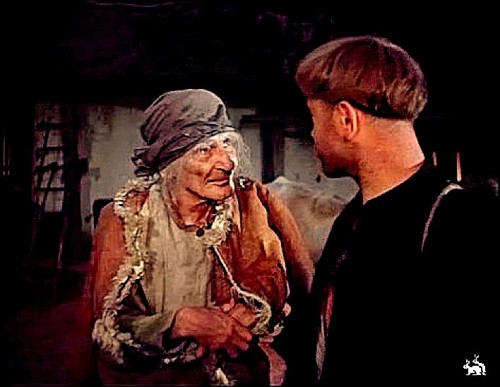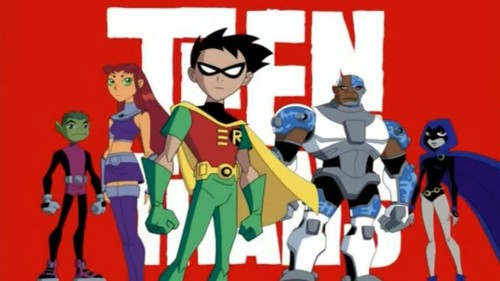
Trigger Warning: Discussion of maternal incest, paternal incest and the rape of men.
Ukrainian writer Nikolai Gogol disassociated himself from his 1835 story Viy by framing it as an unaltered “Little Russian” (Ukrainian) folk tale, but it is actually a strikingly original, vividly visual and deeply felt Gothic horror that bears only slight resemblance to folklore. Though Mario Bava’s 1960 Black Sunday is officially based on Viy, the most faithful adaptation is a 1967 Soviet production with effects by stop-motion legend Aleksandr Ptushko. I’m analyzing this classic, not the recent remake.
Trainee monk Khoma Brut “never knew his mother,” while the story’s vampiric witch (she drinks baby’s blood) is introduced in a maternal, housewife role. As Katherine Murray discusses on Bitch Flicks, “the substitution of witch for mom or giant for dad is a safe way of exploring children’s fears about their parents.” Gogol’s major source is Zhukovsky’s translation of Robert Southey’s “A Ballad, Shewing How An Old Woman Rode Double, And Who Rode Before Her,” where a monk reads prayers over his cursed mother’s corpse, while demons lay siege to the church. Though not literally mother, Viy‘s vivid witch is the archetype of horror’s monstrous mothers. In 1893’s The Death of Halpin Frayser, the hero blunders into the “blank, dead eyes of his own mother, standing white and silent in the garments of the grave!” While struggling with his undead mother in a haunted forest, Halpin dissociates and views events “as a spectator” before dying horribly. In Carl Theodor Dreyer’s 1932 horror classic, Vampyr, Joseph Sheridan Le Fanu’s alluringly lesboerotic Carmilla is reimagined as a menacing, maternal vampire-hag, while in “Lies My Parents Told Me,” (Season 7) of Buffy the Vampire Slayer, Spike vamps his mother and she accuses him of sexually desiring her, forcing him to stake her. The event is so traumatic that Spike can be controlled by it, until he defuses his trigger by facing the memory (contrast the show’s dismissive treatment of Faith’s attempted rape/murder of Xander in Season 3’s “Consequences” and Buffy’s violation of Spike’s stated sexual boundaries in Season 6’s “Gone”).
In her discussion of the female Gothic, “The Madwoman’s Journey From The Attic Into The Television,” Bitch Flicks‘ guest writer Sobia notes, “while male writers of the time were tackling subjects like rape and sexual assault head on, the women were using complicated metaphors to confront these issues. I would argue that for the male writer, given the distance they already have and maintain from these topics, it was easy to tell the story of the assault happening to an Other.” Just as Godzilla‘s semi-goofy lizard embodied Japan’s nuclear trauma, so Gogol’s fantasy creations are not necessarily trivial, as unreal displacements of real anxiety. Viy parallels the female Gothic’s allegorical approach to rape, contrasting sharply with unreal yet realist rape fantasies like Murmur of the Heart (flippant maternal incest for shock value), White Palace (Susan Sarandon’s rape of an unconscious James Spader, who refused consent before passing out, as romantic liberation), and Wedding Crashers (Vince Vaughn’s rape by Isla Fisher as hilarious).

The boisterous tone of Viy‘s opening fades rapidly, as three seminary students, lost in the dead of night, draw up to a housewife’s misty gates and are allowed to stay on condition that they sleep separated. Leonid Kuravlyov’s robust and jolly Khoma beds down alone in a stable. His placid chewing is paralleled with the stable’s cow, reducing him metaphorically to livestock. Initially, Khoma views the looming witch as a joke: “It’s getting late, Granny, and I wouldn’t corrupt myself for a thousand in gold. *laughs* You’ve gotten old, Granny.” Gogol’s prose: “the sophomore [lit: ‘philosopher’] shrank back; but she still approached, as though she wished to lay hold of him. A terrible fright seized him, for he saw the old hag’s eyes glitter in an extraordinary way.” Filming the witch’s stare in uncomfortable close-up, the Soviet adaptation achieves a viscerally uncanny effect, intensified for hetero-male audiences by male actor Nikolai Kutuzov’s playing the witch, until the stumbling Khoma knocks the cow’s yoke symbolically onto his own neck. Khoma appears stunned. In Gogol’s prose, his reaction is more clearly tonic immobility, or freeze response: “the sophomore tried to push her away with his hands, but to his astonishment he found that he could neither lift his hands nor move his legs, nor utter an audible word.”
Finally, the witch grasps him and forces herself onto his back. After a dizzying aerial ride, Khoma drives the witch to earth by invoking Christ and beats her with savage anger, until she transforms into a weeping damsel-in-distress, who dies as he staggers away. The sexual dimension of the riding is clearer in Gogol’s prose: “his legs… lifted against his will… a wearying, unpleasant and at the same time sweet feeling… a demonically sweet feeling… suddenly he felt some kind of refreshment; he felt that his step began to grow more lazy… her wild cries… became weaker, more pleasant, purer.” Gogol uses supernatural paralysis and running motion to allegorically express concepts as crucial to understanding male rape as they are widely disbelieved: firstly, the effectiveness of sexual threat in inducing an involuntary freeze response and, secondly, the possible coexistence of “demonically sweet” arousal with traumatic mental repulsion and violation.

Once dead, the witch can become youthfully beautiful, revealing her aged ugliness as a device to emphasize the unwanted and repulsive nature of the pseudosexual encounter. Khoma is forced to read prayers over the dead witch, as her dying request. Gogol’s witch is as pitiful as she is aggressive, crying a tear of blood and inducing Khoma’s guilt for killing her – “he felt as though those ruby lips were colored with his own heart’s blood” – before demonically rising to violate him again. Khoma is told of Mikita, a huntsman whose infatuation with the witch “completely sissified him” before he allowed her to ride him; he was “burned completely out,” leaving only ashes, proving the fatal seriousness of the riding Khoma has survived. The film’s church scenes are masterpieces of brooding Orthodox iconography, steadily ratcheted tension and jolting jump scares. As the witch rises from her grave, Khoma desperately draws a chalk circle around himself, bolstering its charmed impenetrability by fervent prayer as demons fumble for him.
The frail boundary of chalk serves as a powerful imaginary line of bodily autonomy that the hero desperately defends, and our anxiety over its penetration drives the film’s second half. Khoma is forced to return on the third night by threats and the promise of a thousand in gold (for which he earlier refused to “corrupt himself”), being caught as he tries to flee. After dancing in wild abandon, his macho bravado drives him to return to the scene of horrors, intoxicated, to prove that “Cossacks aren’t afraid.” Khoma thus strives for some sense of control by proactively inviting a seemingly unavoidable threat. This is a common response to chronic abuse. On the final night, gigantic grasping hands grope for Khoma, while a wild assortment of nightmare ghouls crawl out of the church’s woodwork. The witch orders them to bring the Viy, a stumbling grotesque with dangling eyelids, from under the earth. Ghouls raise the Viy’s eyelids, unveiling his glittering stare. Khoma swears he will not look, but cannot resist turning as the Viy’s heavy footfalls approach. The Viy immediately stabs his finger at him, ghouls descend and Khoma dies of fright beneath their grasping hands. In a coda, his friend declares, “If he had not feared her, the witch could have done nothing to him.” As with Spike’s vampire-mother, it is Khoma’s fatal fear of facing the buried monster that is his doom, not the supernatural itself.

Gogol’s earlier 1832 horror, Terrible Vengeance, shares deep parallels with Viy. Like Viy‘s beautiful witch, its sorcerer is superficially attractive, amusing crowds until a religious icon exposes his monstrous true face. The heroine, Katerina, fears the sorcerer and is ambivalently detached from her father, suffering horrifying dreams that he incestuously desires to marry her. Her husband, Danilo, eventually discovers that the father and the evil sorcerer are one, and are conjuring Katerina’s spirit from her body by night. That spirit’s statement that Katerina “does not know a lot of what her soul knows” remarkably suggests repressed memory and dissociation. Like Khoma’s pity for the weeping witch, Katerina feels bound to liberate her father even after realizing his true nature, yet simultaneously self-loathing for her inability to separate from him. Terrible Vengeance portrays a nightmare vision of intergenerational abuse, where ancestors feed forever on each other’s corpses in a deep abyss. The original sinner gnaws his own flesh and shakes the earth in his efforts to rise, eternally growing and distorting into a buried grotesque like the fearful Viy. In Mikhail Titov’s 1987 animated adaptation, Katerina, maddened by the loss of her husband and child, dances in wild, defiant intoxication, as Khoma does after his night terrors, even drawing a circle of fire to ward off her father, like Khoma’s of chalk. Such profound parallels between the quasi-maternal incest of Viy and the explicitly paternal incest of Terrible Vengeance send a clear message: it’s not about gender. Though Gogol’s sexually monstrous mother-figure has captured male imaginations and spawned imitations in a way that his sexually monstrous father has not, because of the overwhelming male authorship of our culture, yet both images are rooted in a potentially interchangeable empathy for survivors of sexual abuse.
[youtube_sc url=”https://www.youtube.com/watch?v=TEenjdEp8h4″]
Titov’s Terrible Vengeance. Triggery allegory
For women, male anxieties over female abusers combine great risk of demonization with great opportunity to forge connection. Men, like women, understand boundaries primally through their own bodies and identification. Rejecting one’s own abuse teaches one to fight against all abuse; excusing it teaches one to abuse. When Alex Forrest of Fatal Attraction spooked male audiences, we could have pointed out that her behavior is stalking, experienced by one in six women in the USA, and her attempt to force Dan’s paternity is reproductive coercion, experienced by 16 percent of pregnant women. Instead, Susan Faludi’s Backlash read Alex as representing the demonization of feminism. Yet, Alex is an abuser. As Stephanie Brown points out for Bitch Flicks, you may meet Alex as you progress through life. Society does not technically favor men over women in intimate relationships. It favors abusers over victims, and codes abusive behaviors as masculine. As for bad mothers, Freud’s Oedipal “seduction theory” was created under intense pressure from the psychiatric establishment, as an alternative to his earlier exposure of parental incest’s links to PTSD in “The Aetiology of Hysteria.” So, why do feminists apply Oedipal interpretations, that evolved by mirror logic from rape apologism, to dismiss texts like Viy? Ultimately, whatever nightmares they fuel, bad mothers are neither monsters nor demonically unnatural women. They are flawed humans. By resisting the gendering of abuse, can we evolve human understanding?

The paranoid repulsion towards female sexual aggression that pervades the work of Nikolai Gogol has seen him uncritically labeled a misogynist, by virtually all modern commentators. Yet, renowned misogynist Nikolai Gogol formed intense friendships with women like Alexandra Smirnova-Rosset, corresponding on philosophical topics with rare respect for her intellectual equality, and addressing her as “drug” (“buddy”). Renowned misogynist Nikolai Gogol wrote the 19th century’s most psychologically insightful and empathetic portrait of a female experience of paternal incest. Renowned misogynist Nikolai Gogol understood abuse far better than mainstream feminism. Time to stop dismissing and listen to the boys. Time to face Viy without flinching.
See also at Bitch Flicks: “Child-Eating Parents in Into the Woods and Every Children’s Story Ever”
Brigit McCone freely admits to being a Gogol groupie, writes and directs short films and radio dramas. Her hobbies include doodling and social justice warring.






